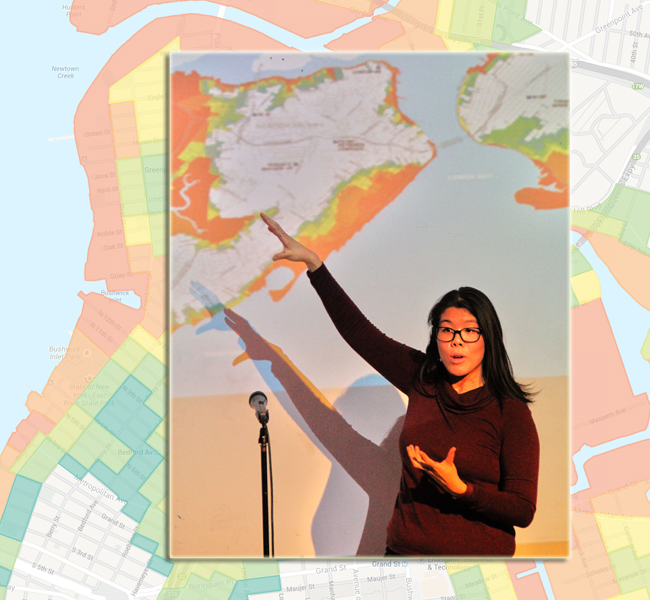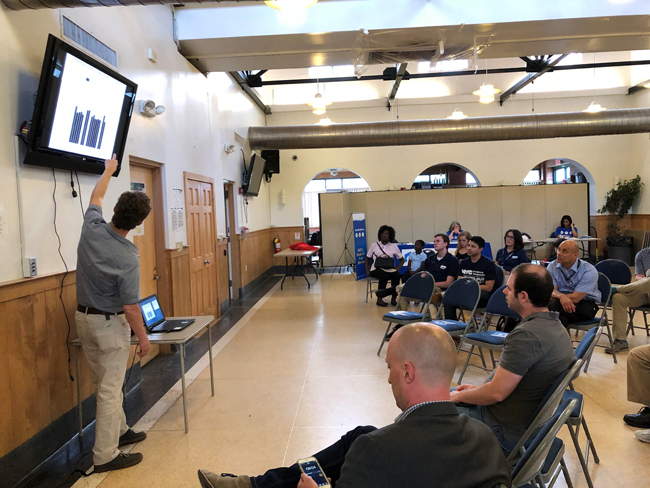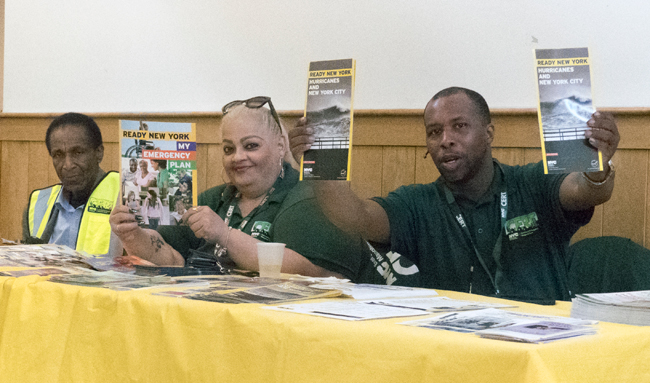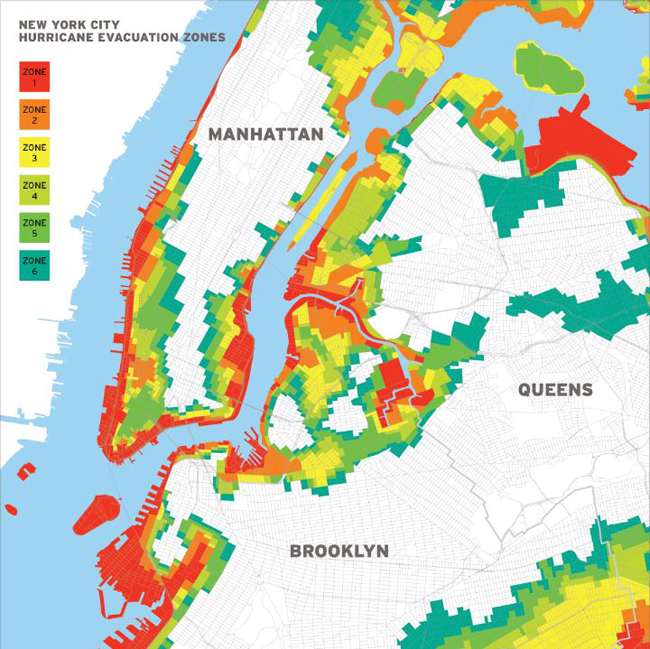
In addition to planning the Climate Forum Series, NYSG's Jamaica Bay Coastal Resilience Specialist Helen Cheng also presents at meetings such as late February 2017's Science Salon for Puerto Rico, which was hosted by Taste of Science NYC, 500 Women Scientists NYC pod, and NYC Ecowomen. Credit: Christopher Uller.
Contacts:
Helen Cheng, NYSG's Coastal Resilience Extension Specialist, E: helen.cheng@cornell.edu P: (718)-951-5415
New York, NY, May 3, 2018 – New York Sea Grant (NYSG) and the Science and Resilience Institute at Jamaica Bay hosted its fifth Climate Forum in the Bergen Beach–Mill Basin neighborhood of South Brooklyn. The Climate Forum series seeks to create a dialogue between the community and agencies and researchers, and share information, resources, and perspectives. Working with local community leader, Millennium Development Inc., this Climate Forum presented information regarding flooding and flood preparedness. Four experts gave presentations covering various aspects of flood risk, preparedness, and long-term adaptation.
Daniel Bader, the Program Manager at the Consortium for Climate Risk in the Urban Northeast (CCRUN) presented on the flood hazards in New York City. Over the last century the mean sea level has risen by about one foot—a figure that’s slightly higher in New York due to geologic factors. Bader explained that with the combined impacts of sea level rise, coastal storms, and heavy precipitation events, these could exacerbate damage caused by inland and coastal flooding. Bader stressed the importance of tailoring flood response to the most scientifically accurate information available.

Dr. Philip Orton, Stevens Institute of Technology, presents information on historical extreme water levels at New York City. Hurricane Sandy was the highest flood in the city's history. Credit: Ryan Strother/NYSG.
Phillip Orton, a Research Assistant Professor of Ocean Engineering at the Stevens Institute of Technology, presented information on understanding flood risk. Flooding levels that occurred during Hurricane Sandy also took place 180 years ago in South Brooklyn. Storm events like Sandy, while devastating, are not as common as a mid-sized storm, which are more likely to occur. Current flood preparedness efforts should be ready for the most likely scenario of an intermediate storm which can still cause disruption of services and damage. For forecast information on flood risk and storm preparation, visit the Stevens Flood Advisory System: www.stevens.edu/SFAS.

The local Community Emergency Response Team (CERT) presents NYC Emergency Management information at the event. Credit: Ryan Strother/NYSG.
Sam Lawson from NYC Emergency Management presented on the process at which hurricane evacuation occurs. Four days prior to zero hour—when winds reach tropical storm levels on shore and just before a storm makes landfall — an alert is issued to citizens potentially impacted by a storm. Three days prior to zero hour, healthcare facilities are evacuated and schools close. This is also when most families should be prepared to evacuate with a Go-Bag and supplies. Two days before zero hour, the Mayor of New York City will call for an evacuation, and resources will be provided for evacuating people especially those with disabilities. Within two days of zero hour, the Emergency Management recommends that all families should already be evacuated. For more information on emergency preparedness, visit www.nyc.gov/emergencymanagement.
Finally, Elizabeth Malone from the organization FloodHelpNY presented on the history and current state of flood insurance in New York and around the country. Malone explained that the National Flood Insurance Program (NFIP) was created in 1968 and was modeled after the response to the 1926 Mississippi river valley flooding. In 1983, New York City adopted the Flood Insurance Rate Map (FIRM) and codes. However, by 2005 after five east coast storms, the NIFP was sent into debt. By 2012 when Hurricane Sandy hit, the NIFP was $17 billion in debt to the treasury. These financial and climate related factors necessitate NYC-specific considerations to sustainable development and flood insurance. To learn more, visit www.floodhelpny.org.
Helen Cheng, NYSG’s Coastal Resilience Specialist, coordinated and hosted the event.
“People are looking for information and resources in preparation for what’s to come,” said Cheng. “The Climate Forums not only fosters the presentation of information but also puts a face to a name and builds relationships. Having these types of dialogues and interactions are important in building trust so that we can work to address future risks and challenges together.”

A detail from the NYC Hurricane Guide, with color-coded evacuation zones. These colors and zones are represented in the Know Your Zone logo as six concentric rings. Credit: NYC Office of Emergency Management.
More Info: New York Sea Grant and SRIatJB
The Science and Resilience Institute @ Jamaica Bay
(SRIJB) is a research center focused on enhancing environmental,
social, and economic resilience in communities of Jamaica Bay funded by
the Rockefeller Foundation and the City of New York.
New York Sea Grant (NYSG), a cooperative program of Cornell University
and the State University of New York (SUNY), is one of 33 university-based
programs under the National Oceanic and Atmospheric Administration’s
National Sea Grant College Program.
Since 1971, NYSG has represented a statewide network of integrated
research, education and extension services promoting coastal community
economic vitality, environmental sustainability and citizen awareness
and understanding about the State’s marine and Great Lakes resources.
Through NYSG’s efforts, the combined talents of university scientists
and extension specialists help develop and transfer science-based
information to many coastal user groups—businesses and industries,
federal, state and local government decision-makers and agency managers,
educators, the media and the interested public.
The program maintains Great Lakes offices at Cornell University, SUNY
Buffalo, SUNY Oswego and the Wayne County Cooperative Extension office
in Newark. In the State's marine waters, NYSG has offices at Stony Brook
University in Long Island, Brooklyn College and Cornell Cooperative
Extension in NYC and Kingston in the Hudson Valley.
For updates on Sea Grant activities: www.nyseagrant.org has RSS, Facebook, Twitter, and YouTube links. NYSG offers a free e-list sign up via www.nyseagrant.org/nycoastlines for its flagship publication, NY Coastlines/Currents, which is published quarterly. Our program also produces an occasional e-newsletter,"NOAA Sea Grant's Social Media Review," via its blog, www.nyseagrant.org/blog.